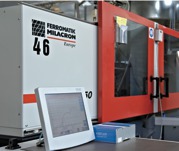

|
Edward Lowton
Editor |


|
Cavity pressure monitoring
12 August 2014
German injection moulding specialist, neo-plastic Dr. Doetsch Diespeck uses cavity pressure to determine the switchover to holding pressure for process optimisation, and cavity pressure-based monitoring from Kistler Instruments for quality assurance. Both direct and indirect cavity pressure measuring is used and is said to ensure minimum rejects.

Injection moulding of hinge covers is an example of seamless in-line quality assurance. These flat, palm-size SEBS parts protect sensitive electric seat adjustment systems during the production of foamed car seat systems. The seat manufacturer inserts the injection moulded covers into a mould, where they form a tight bond with the seat during foaming. Although in a concealed place, they need to be precisely moulded to ensure they are fully functional.
An injection moulding machine was equipped with a machine control system that provides outputs for pressure signals and integrated cavity pressure monitoring. Each cavity of the 2+2-cavity hot-runner family mould for the production of right-side and left-side hinge covers has Kistler 2.5mm pressure sensors.
For other projects, the company deploys Kistler’s CoMo Injection system. "CoMo is fully configured for analysing and monitoring injection moulding processes. When it comes to direct comparison, machine control systems provide rather limited analysis options," says managing director, Patrick Freiherr von Twickel.
"With new, medium-term projects with six or seven-digit annual output rates, neo-plastic operates with cavity pressure technology right from the start. This applies to the production of a small technical PA46 breaker plate with a shot weight of only 3.5g. A new 8-cavity mould is equipped with eight direct 1mm pressure sensors. Again, the CoMo Injection process monitoring system will control the process by means of cavity pressure-dependent switchover and guarantees the quality of the moulded parts by monitoring the pressure curves. Without sensors, this project would generate massive problems due to underfed parts. Automatic switchover makes the process significantly more stable.
"Cavity pressure dependent switchover facilitates and speeds up any setup changes: after 10 shots with the new mould, the quality is perfect again. During the active production process, lot variations or changes of flow are registered immediately and can be remedied directly. Assuming an out-put rate of 200,000 parts per year, I would expect the system to have paid off after 18 months."
After several years use, von Twickel is able to sum up the benefits of cavity pressure measuring and the integration of Kistler sensors and systems: "I can look into the cavity. That constitutes an unbeatable advantage. I have not encountered any other method that would deliver similar information. Today, we are working in the mould, not in the machine."
- Reference shaker
- Quality & costs under control
- Miniature low level force sensor
- Pressure sensors
- Highly dynamic pressure sensor with 500kHz natural frequency
- Torque sensor
- Designed for high precision measurements
- Miniature sensor for very low force measurement tasks
- Piezoelectric dynamometer
- Supporting Rosetta's final manoeuvre
- No related articles listed

















